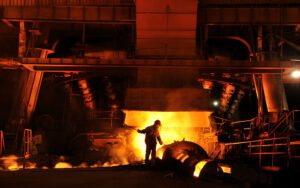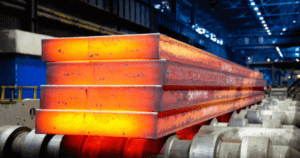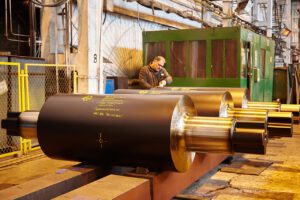
Electric steelmaking complex Interpipe Steel, part of international vertically integrated pipe and wheel company Interpipe (Dnipro), in January-July of this year increased steel production, according to recent data, by 19.9% compared to the same period last year, to 537,000 tonnes.
As the company told Interfax-Ukraine, 79,000 tonnes of steel were produced in July.
In 2020, the company reduced steel production by 11.2% compared to 2019, to 758,700 tonnes.
Interpipe is a Ukrainian industrial company, a manufacturer of seamless pipes and railway wheels. The company’s products are supplied to more than 80 countries all over the world through a chain of commercial offices located in the CIS, Europe, the United States and the Middle East.

Ukraine in January-July this year reduced exports of semi-finished products from carbon steel in quantity terms by 3.2% compared to the same period last year, to 4.177 million tonnes.
According to statistics released by the State Customs Service, during the specified period, exports of semi-finished products from carbon steel increased in monetary terms by 51.2%, to $2.344 billion.
The products were mainly exported to Italy (31.35% of supplies in monetary terms), Turkey (17.45%) and the Dominican Republic (8.31%).
In addition, Ukraine in January-July 2021 imported 12,806 tonnes of such products, which is 40.7% more than in January-July 2020. In monetary terms, imports increased 2.1 times, to $7.990 million. The products were mainly imported from the Russian Federation (94.04% of supplies), Uzbekistan (3.49%) and Turkey (2.38%).

Metinvest, the largest Ukrainian mining and metallurgical holding, in January-June this year increased crude steel production by 10% compared to the same period last year, to 4.358 million tonnes, cast iron – by 8%, to 4.405 million tonnes, but reduced total coke production by 0.2%, to 2.368 million tonnes.
According to a press release of parent company Metinvest B.V. on the results of operation in H1 2021 published on Wednesday, In 2Q 2021, Metinvest’s hot metal output climbed by 5% q-o-q to 2.254 million tonnes. This was driven by growth in Azovstal’s production of 107,000 tonnes following brief maintenance and repair work on blast furnaces in March because of the planned overhaul of basic oxygen furnace (BOF) No. 1 that month.
In 2Q 2021, the Group’s crude steel output rose by 5% q-o-q to 2.229 million tonnes because of an increase in Azovstal’s volumes of 130,000 tonnes amid greater hot metal production at the plant. Meanwhile, Illich Steel’s output decreased by 30,000 tonnes because of the scheduled overhaul of BOF no. 3 in May.
In H1 2021 hot metal and steel output grew thanks to an increase in production at the two Mariupol-based works.
In 2Q 2021, the Group’s output of merchant semi-finished products dropped by 10% q-o-q to 687,000 tonnes. Merchant slab production fell by 91,000 tonnes because of the allocation of slabs to make more flat products. Meanwhile, pig iron output edged up by 13,000 tonnes.
In 1H 2021, Metinvest’s production of merchant semi-finished products decreased by 4% y-o-y to 1.452 million tonnes. Merchant slab production declined by 131,000 tonnes because of the redistribution of slabs to flat product rolling. Pig iron production rose by 66,000 tonnes, mainly because of an increase in hot metal output.
In 2Q 2021, the Group’s output of finished products climbed by 9% q-o-q to 1.819 million tonnes.
In 1H 2021, Metinvest’s production of finished products surged by 22% y-o-y to 3.481 million tonnes.
In 2Q 2021, the Group’s coke output totalled 1.198 million tonnes, up 2% q-o-q, mainly because of an increase in production at Avdiivka Coke following the overhaul of coke oven battery No. 6 in the beginning of this year. In 1H 2021, coke output remained flat y-o-y at 2.368 million tonnes. The effect of the consolidation of production volumes of Dnipro Coke since April 2020 (124,000 tonnes) was almost completely offset by decreases in production at Avdiivka Coke of 81,000 tonnes and Azovstal of 46,000 tonnes.

PJSC Energomashspetsstal (Donetsk region), owned by Russia’s Atomenergomash (Rosatom State Corporation), in January-July this year reduced steel production, according to recent data, by 20.5% compared to the same period last year, to 31,000 tonnes.
A source in the industry told Interfax-Ukraine that 2,000 tonnes of steel were produced in July.
As reported, Energomashspetsstal in 2020 increased steel production by 6.8% compared to the previous year, to 63,000 tonnes.
Energomashspetsstal is the largest Ukrainian manufacturer of special cast and forged products of individual and small-scale production for metallurgy, shipbuilding, energy (wind, steam, hydro, nuclear) and general mechanical engineering.
DONETSK, DONETSK REGION, ENERGOMASHSPETSSTAL, STEEL, STEEL PRODUCTION

Metinvest Mining and Metallurgical Group through PrJSC Dniprovsky Coke and Chemical Plant (DKHZ, Kamianske, Dnipropetrovsk region), part of the group, will acquire an integral property complex of Dniprovsky Integrated Iron & Steel Works (DMK, Kamianske, Dnipropetrovsk region) for UAH 9.17 billion with a starting price of UAH 8.395 billion.
According to the information on the ProZorro.Sales platform, bids were accepted until July 25 inclusive, the auction was scheduled for July 26, but since one bid was submitted for the competition, the winner was determined without bidding.
Earlier, Interfax-Ukraine was informed that Metinvest would acquire DMK through its company, DKHZ.
DMK was undergoing reorganization as part of the bankruptcy proceedings of the enterprise.